
 Image: Matt Smith
Image: Matt Smith
 At a glance
At a glance
Expert’s Rating
Pros
Good contrast ratio for the priceStrong color performance120Hz refresh rateFunctional, ergonomic design
Cons
Limited video connectivityUSB-C upstream port doesn’t include Power Delivery
Our Verdict
Dell’s Ultrasharp U2724D is an excellent overall monitor with strong image quality, great ergonomics, and features that allow for flexible use cases—office productivity, content creation, and even gaming. It’s a mid-range monitor that easily handles any task you throw at it.
Price When Reviewed
$384.99
Dell’s Ultrasharp monitors have long ranked among my go-to recommendations (and I’ve bought a couple myself over the past decade), but high pricing and a narrow focus on productivity can limit their appeal. Dell’s U2724D resolves those issues with an IPS Black panel that boasts a refresh rate of 120Hz. It’s responsive, fluid, attractive, and reasonably priced.
Further reading: See our roundup of the best home office monitors to learn about competing products.
What are the Dell Ultrasharp U2724D’s specs and features?
The Dell Ultrasharp U2724D’s basic specifications are typical for a mid-range 27-inch monitor. It has a native resolution of 2560×1440 and a maximum refresh rate of 120Hz. The one difference—and it is a key difference—is its use of an IPS Black panel, which gives Dell an edge in image quality over its competition.
Display size: 27-inch widescreenNative resolution: 2560×1440Panel type: In-Plane Switching (IPS) BlackRefresh rate: 120HzAdaptive sync: VRRHDR: NonePorts: 1x HDMI 2.1 with VRR, 1x DisplayPort 1.4-in, 1x DisplayPort 1.4-out, 1x USB-C upstream (data only), 1x USB-C downstream, 2x USB-A downstreamVESA mount: 100x100mmSpeakers: NonePrice: $384.99 MSRP
Dell sells an alternative version of this monitor, the U2724DE, which supports a much wider range of connectivity including Thunderbolt 4 and 2.5G Ethernet. That unfortunately means the less expensive U2724D lacks some connectivity I might expect, like a USB-C port with DisplayPort and USB Power Delivery, though it does retain DisplayPort-out. Sacrificing connectivity lowers the MSRP from $649.99 (for the U2724DE) to $384.99 (for the U2724D).
mentioned in this article
Dell U2724DE
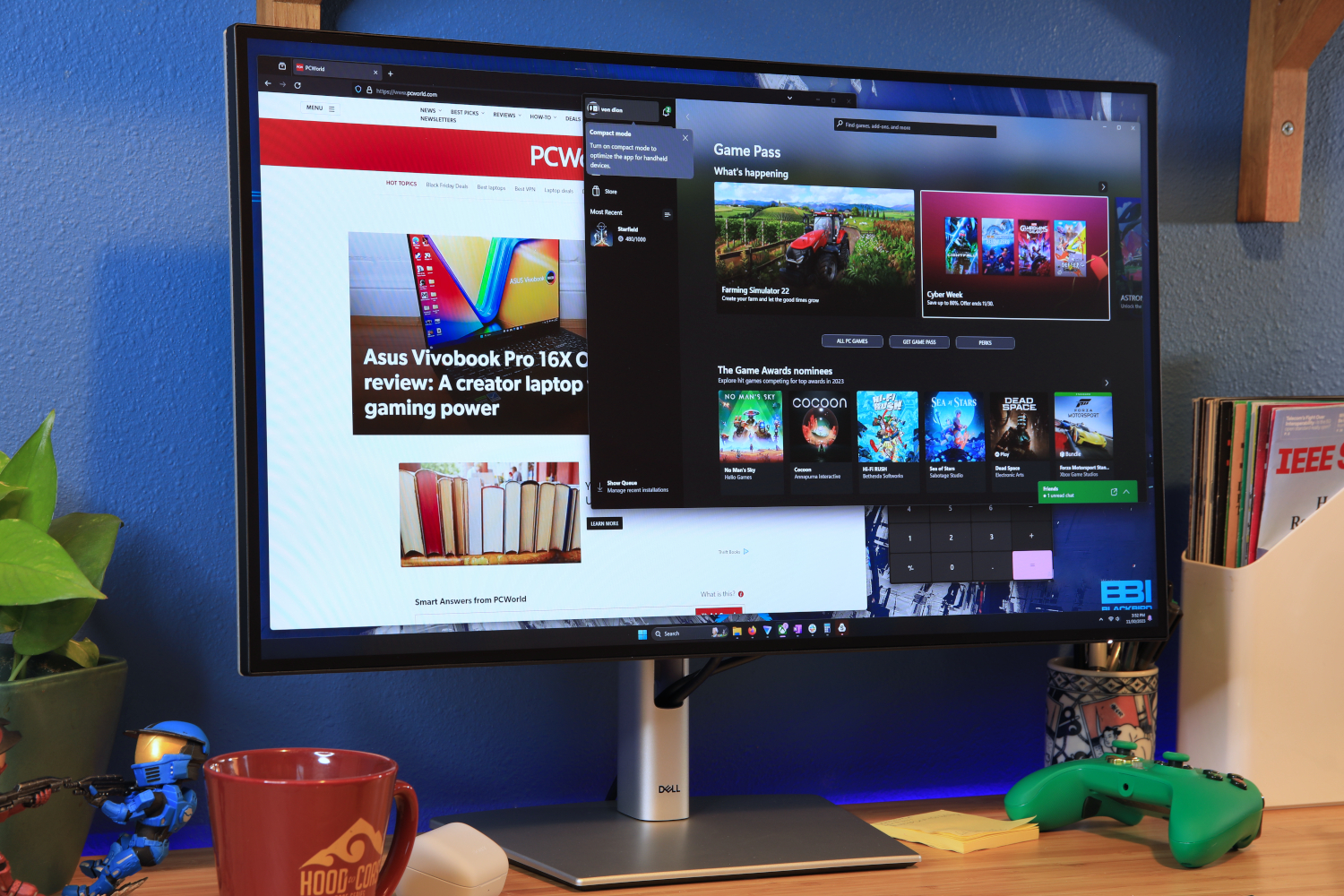
 Read our reviewBest Prices Today:$649.99 at Dell
Read our reviewBest Prices Today:$649.99 at Dell
How is the Dell Ultrasharp U2724D’s design?
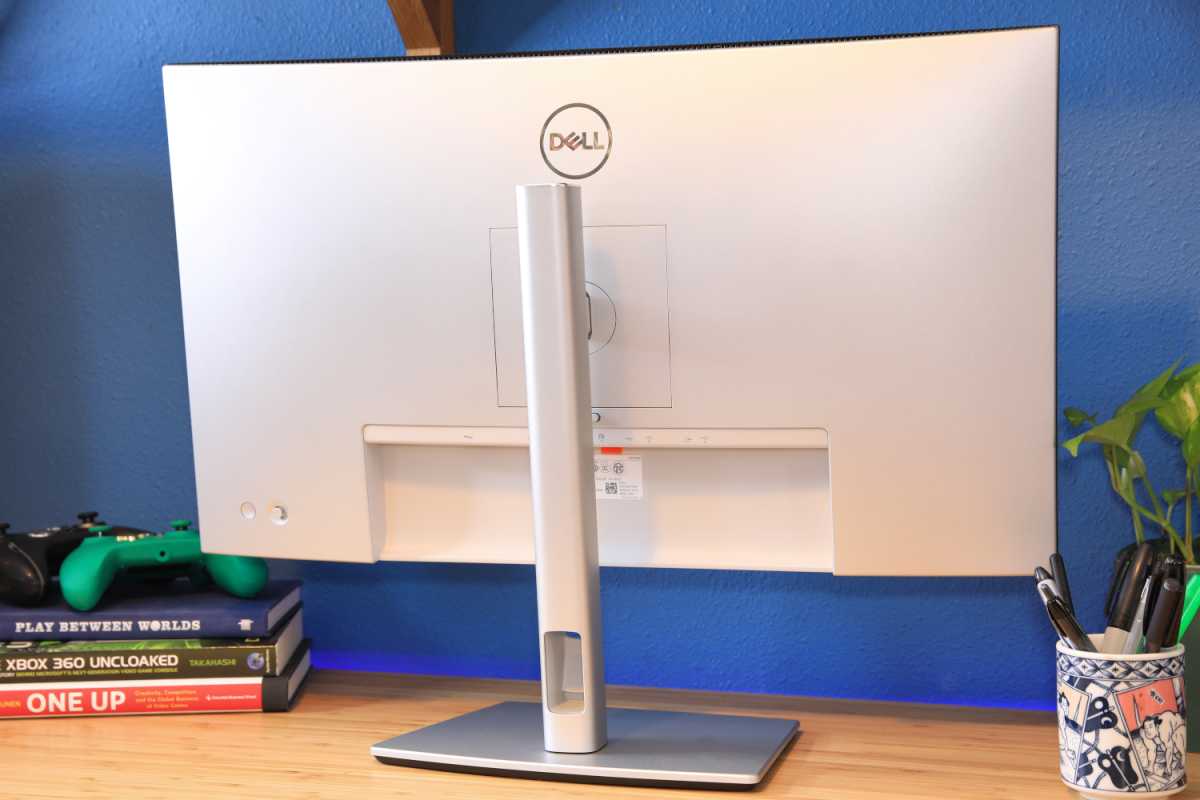
The Dell Ultrasharp U2724D comes with a plastic backside with a brushed aluminum look that is surprisingly robust.
The Dell Ultrasharp U2724D comes with a plastic backside with a brushed aluminum look that is surprisingly robust.
Matt Smith
The Dell Ultrasharp U2724D comes with a plastic backside with a brushed aluminum look that is surprisingly robust.
Matt Smith
Matt Smith
The Dell Ultrasharp U2724D adheres to the brand’s aesthetic with a slim design and narrow bezels on all sides of the display. They’re so thin, in fact, that there’s no room for the Dell logo on the chin, which results in a generic (but super-sleek) look.
View it from the rear and you’ll find a swath of vibrant silver plastic that effectively imitates a brushed aluminum finish. Plastic is the material of choice for the monitor’s exterior, but you’d be hard-pressed to notice without touching the monitor. The monitor feels robust when handled, too. Panels allow little flex and don’t emit disconcerting creaks or groans.
Dell’s compact, flat stand comes standard, and it’s still among the best available. Its design minimizes the monitor’s footprint on your desk and, because the stand is flat, you can still use most of the space it occupies to stack books, gadgets, or other items. Cable routing is built into the stand and provides enough space to manage the power cord, display cords, and several USB cords.
The stand also provides ergonomic adjustment including 150mm of height adjustment, 90 degrees of swivel (45 degrees to the left or right), 26 degrees of tilt, and 90 degrees of rotation (which means it can rotate into portrait orientation). Many home office monitors provide a similar range of adjustment, but it’s good to see Dell nail the fundamentals. A standard 100mm VESA mount is included, as well, for attaching a third-party monitor stand or arm.
How is the Dell Ultrasharp U2724D’s connectivity and menu?
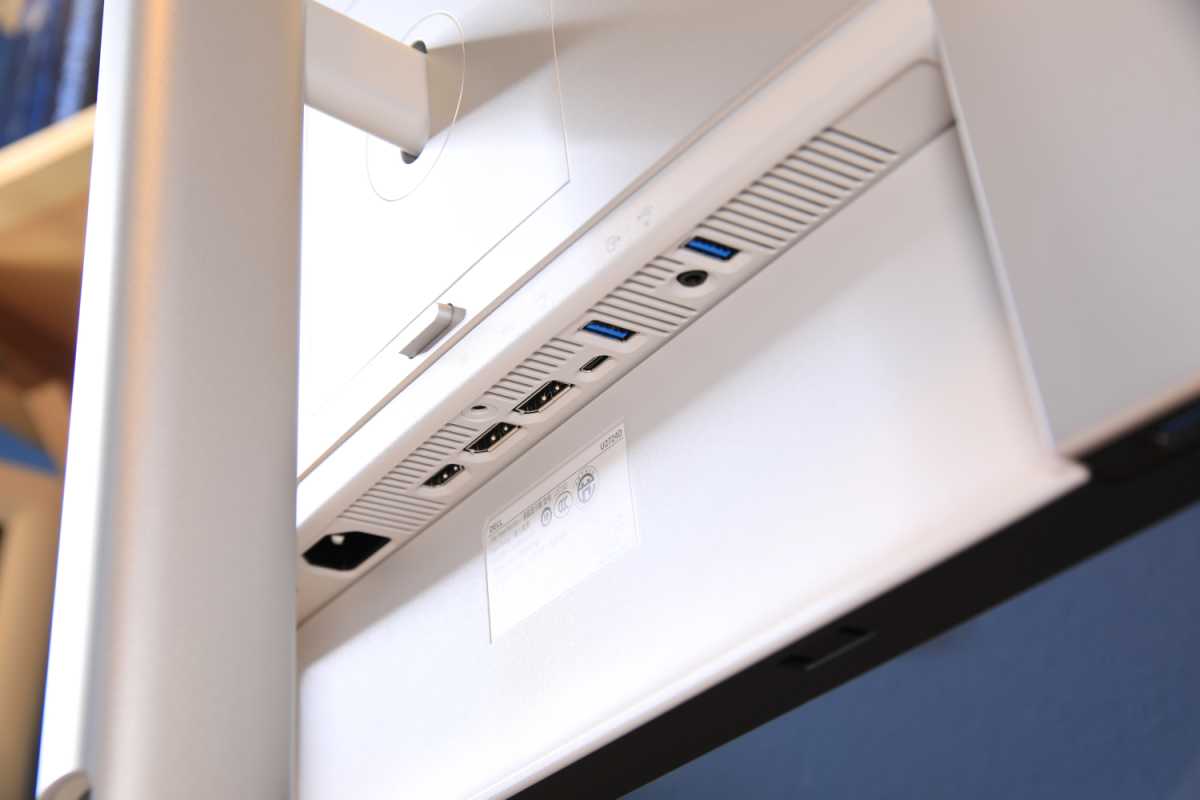
Dell Ultrasharp U2724D’s connectivity features.
Dell Ultrasharp U2724D’s connectivity features.
Matt Smith
Dell Ultrasharp U2724D’s connectivity features.
Matt Smith
Matt Smith
Connectivity is the Dell Ultrasharp U2724D’s sole disappointment. The monitor has one HDMI port, one DisplayPort-in, one DisplayPort-out, and an upstream USB-C data port. However, the USB-C port lacks DisplayPort or USB Power Delivery support. An audio line-out rounds out the options (the monitor doesn’t include speakers).
That leaves the U2724D with just two video inputs, which is unusual for a display in its price range. Most similarly priced monitors provide at least three, sometimes four, video inputs.
But the U2724D does include DisplayPort-out, which makes it possible to daisy-chain a video connection (meaning a second monitor can be connected directly to the U2724). It’s convenient for expanding the video connectivity of a device with limited ports or reducing cable clutter behind a desk.
While the USB-C port doesn’t support video or power, it does connect to three USB downstream ports. Two of these are located on the monitor’s chin, enhancing accessibility. The U2724D is a useful, though limited, USB hub
Whether all this matters depends on how you’ll use the monitor. Desktop users are unlikely to find much fault, since desktops rarely use USB-C for video and don’t benefit from Power Delivery. If you plan to dock a laptop, however, you might prefer the U2724DE, which has Thunderbolt, USB Power Delivery, Ethernet, and additional USB-C connectivity.
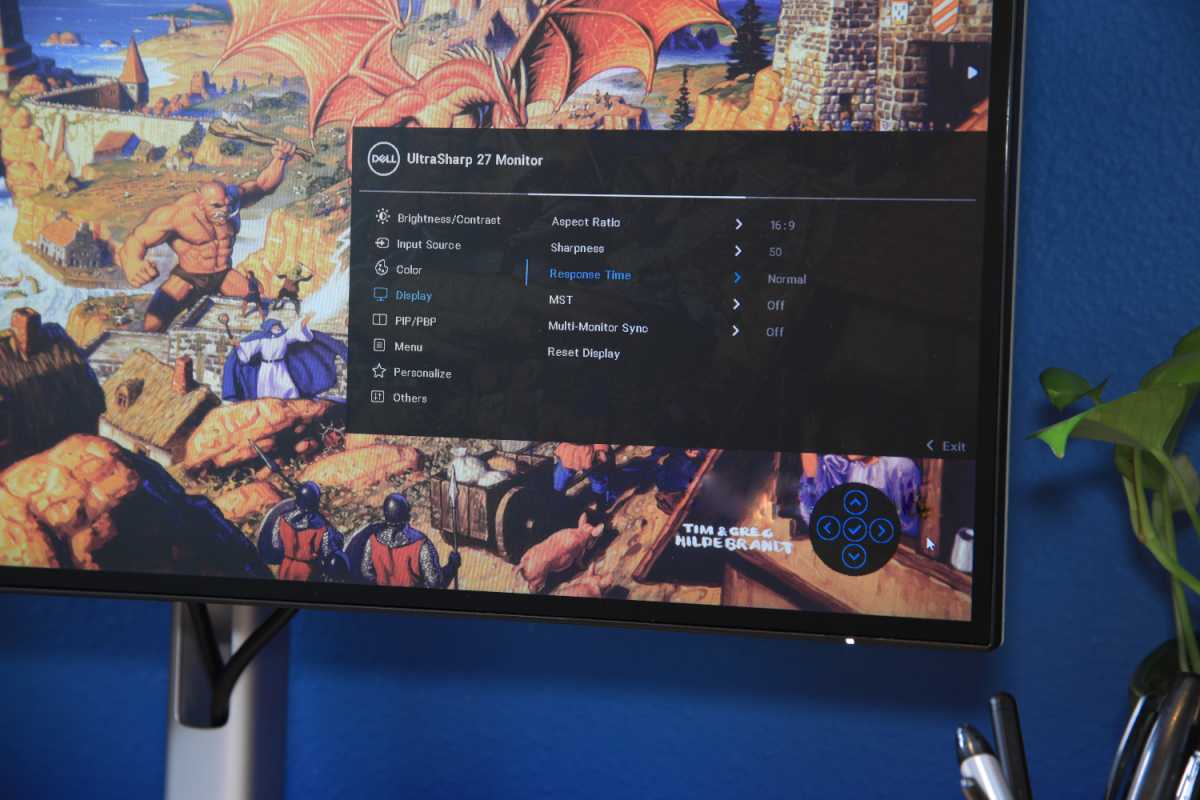
The Dell Ultrasharp U2724D’s menu system is easy to use with decent customization options.
The Dell Ultrasharp U2724D’s menu system is easy to use with decent customization options.
Matt Smith
The Dell Ultrasharp U2724D’s menu system is easy to use with decent customization options.
Matt Smith
Matt Smith
The U2724D’s ports are managed through an easy-to-use on-screen menu accessible with a joystick located near the lower-right bezel. While the menu is user-friendly, the range of image quality settings is just okay. Dell includes a custom color mode, enabling adjustments to RGB colors, and it provides various color temperature choices, which are listed in precise increments (like 6500K) rather than vague generalizations (like “Warm”). The monitor lacks gamma adjustment, though, which feels like a minor oversight.
How is the Dell Ultrasharp U2724D’s SDR image quality?
Dell’s Ultrasharp U2724D is marketed primarily as a home office and productivity monitor, but its 27-inch display panel, versatile 1440p resolution, 120Hz refresh rate, and mid-range price make it a possible fit for nearly anyone looking to buy a monitor. That also places it against stiff competition, as there’s no shortage of affordable 27-inch, 1440p, 120-to-165Hz monitors. But the U2724D has something most monitors don’t: an IPS Black display panel.
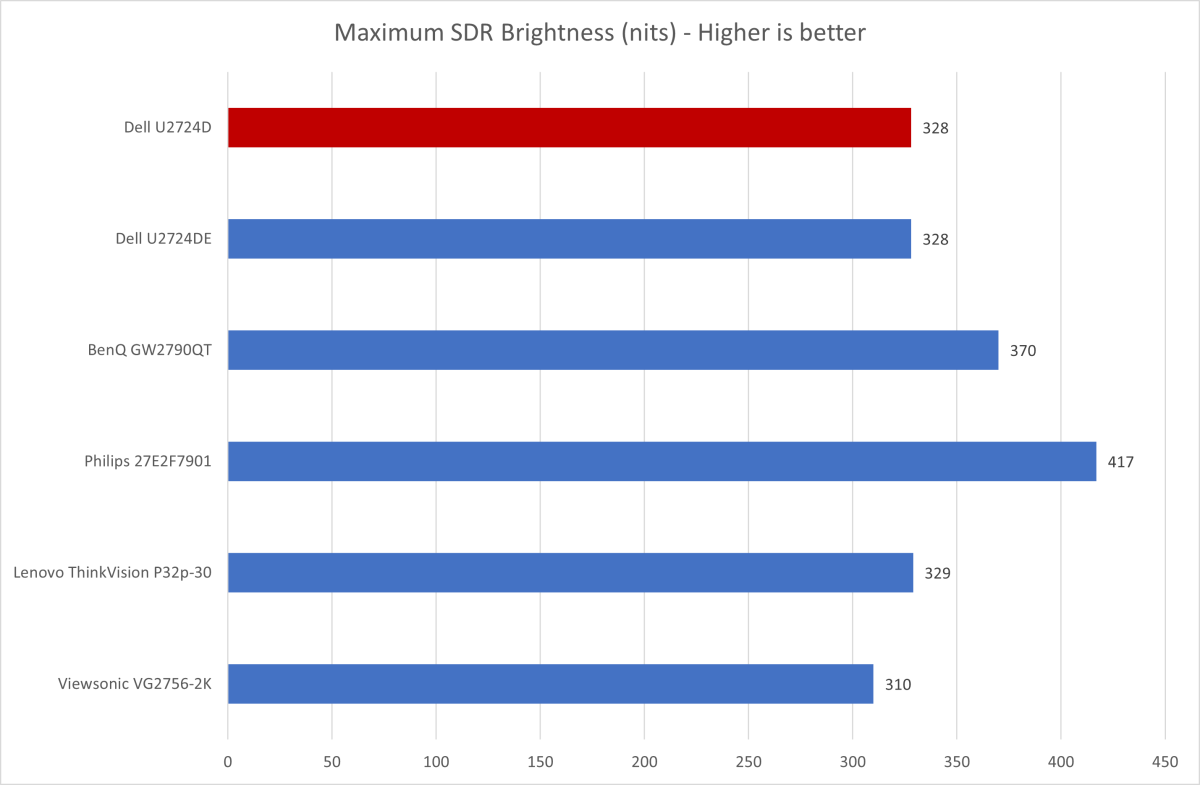
Matt Smith
Matt Smith
Matt Smith
The U2724D’s brightness peaks at 328 nits, which is a tad behind the brightness typically seen in recent monitors, but the U2724D’s brightness exactly matches the U2724DE. That makes sense, given their many similarities, but I was still surprised by just how closely they mirrored one another. It suggests good quality control from Dell.
Though a bit dim compared to other modern IPS monitors, the U2724D’s brightness is fine for nearly all situations. It also has an effective anti-glare coating which minimizes glare, especially when the monitor faces a light source.
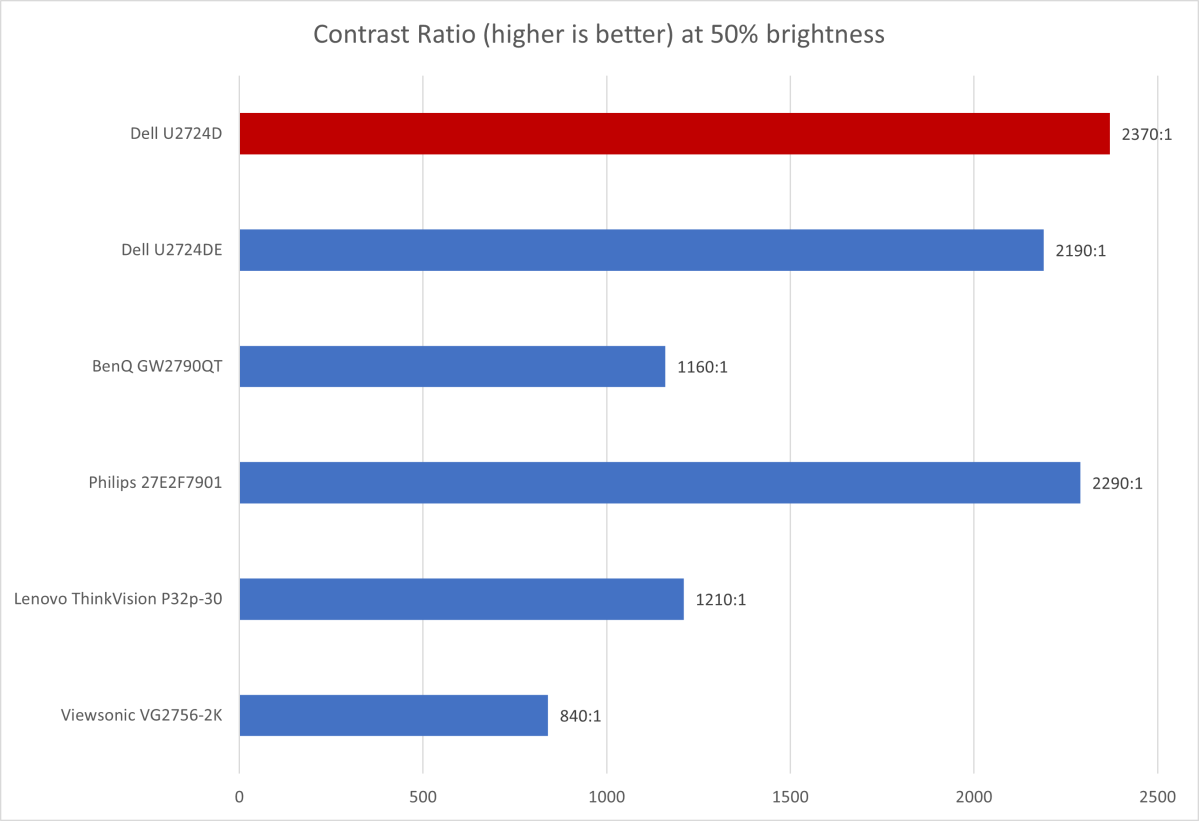
Matt Smith
Matt Smith
Matt Smith
The Dell U2724D offers a strong contrast ratio of 2370:1. That’s slightly better than the U2724D, and the best contrast ratio result of any IPS Black monitor I’ve reviewed so far. Don’t read too much into that, though. I didn’t find this slight difference noticeable in real-world viewing.
Yet the U2724D’s performance is notable for one key reason: the price. It carries an MSRP of just $384.99 (and, if Dell’s history is any guide, will be discounted below that before long), which makes it the most affordable IPS Black monitor yet.
Previous IPS Black Monitors were priced high enough that budget Mini-LED and OLED monitors might be considered an alternative. That’s not the case with the more affordable U2724D, and it makes the monitor’s contrast performance even more appealing. Monitors with a VA panel, like the Gigabyte GS32QC, can deliver superior contrast at an equivalent (and often lower) price—but most such monitors target gaming and lack quality-of-life features found in the U2724D.
The Dell U2724D’s MSRP of just $384.99 makes it the most affordable IPS Black monitor yet.
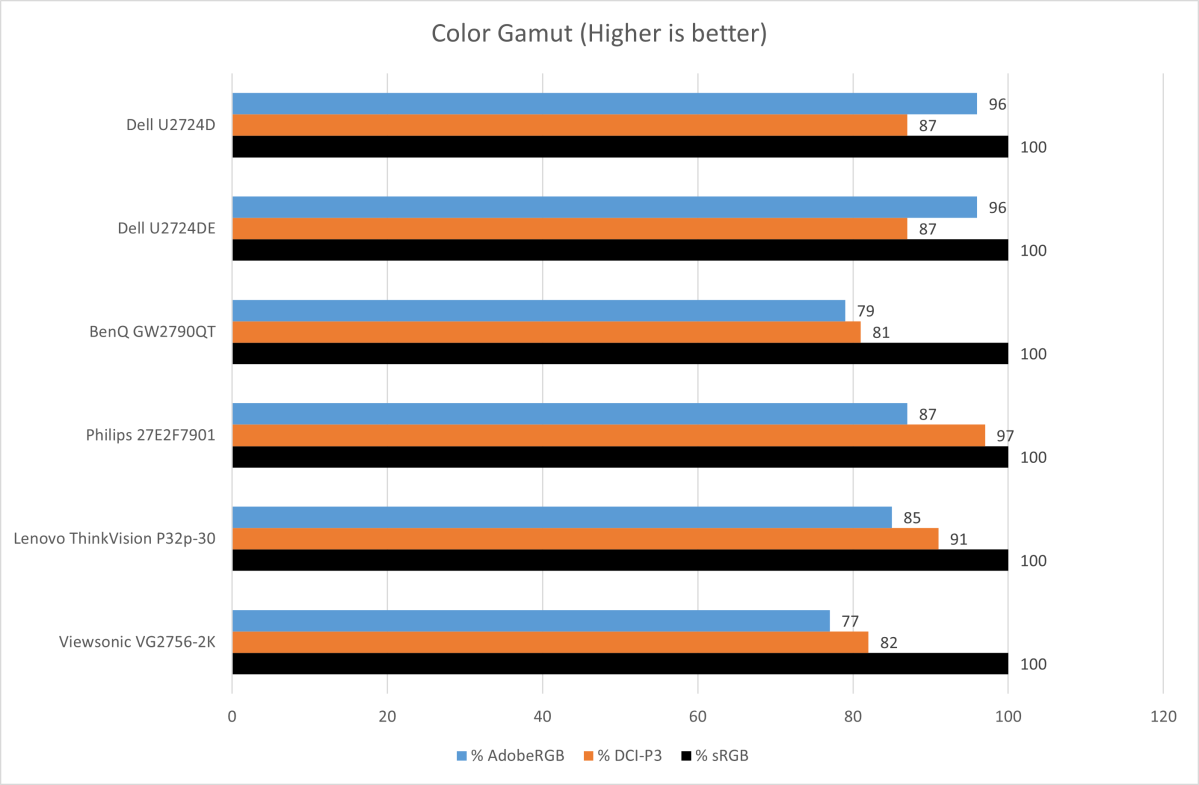
Matt Smith
Matt Smith
Matt Smith
The U2724D’s color gamut covers 96 percent of DCI-P3 and 87 percent of AdobeRGB, results that exactly match the more expensive U2724DE. That’s not the widest color gamut available, but it’s solid for the price and delivers a broad range of color that’s useful for content creators and adds some visual spice to games.
There are a few alternatives, like the Asus’ ProArt monitors like the PA279CRV, which outperform the U2724D’s color. These tend to be more expensive, though, and lack the IPS Black panel. Most people won’t find the improvement in color gamut worth the reduction in contrast.
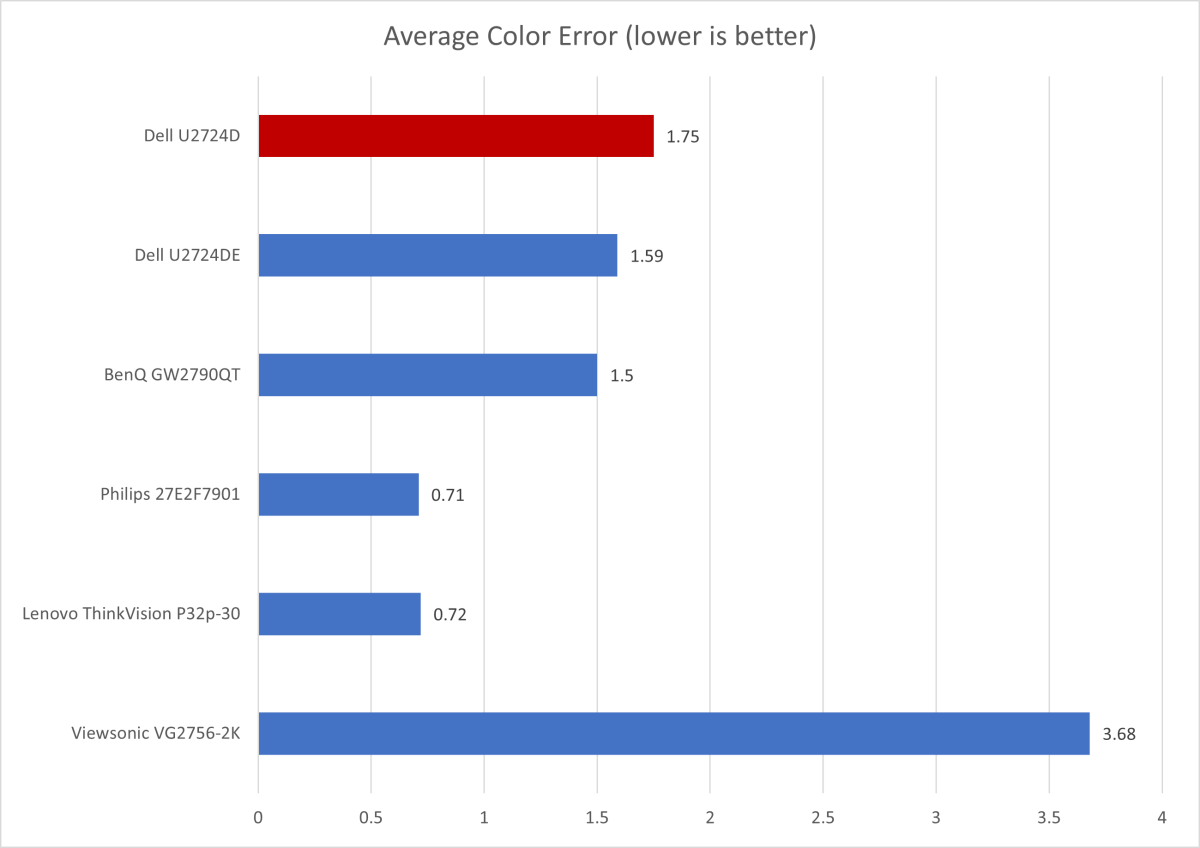
Matt Smith
Matt Smith
Matt Smith
The U2724D’s color accuracy isn’t exceptional, but it’s more than adequate for a home office and productivity monitor. It offers a vivid, realistic image that doesn’t fall out of line when displaying any particular color. The same is true of most competitors, however.
I measured a default color temperature of 6500K, which is exactly in line with my preference. The image didn’t appear overly warm or cool out-of-the-box—and as mentioned, the menu provides color temperature adjustment that helps you tune the monitor to the preference.
Gamma was a bit off, however, with a gamma curve of 2.0. That meant content generally appeared overly bright and luminous, which could over-boost detail in dark and shadowy scenes and lead to a hazy look. The monitor lacks a gamma adjustment, so the problem isn’t as easy to correct as it could be, though it can be fixed through alternative image quality presets or software calibration.
The U2724D has a native resolution of 2560×1440 which, depending on your perspective, might seem disappointing. Dell offers more affordable 4K monitors, like the S2721QS—but these lack the U2724D’s maximum refresh rate of 120Hz. Pixel density comes in at 109 pixels per inch, which looks reasonably sharp on a 27-inch display, though some pixelation is noticeable when viewing very small fonts. On the other hand, 1440p is an ideal resolution for gaming on a 27-inch display, as it provides strong sharpness without the intense GPU requirements of 4K.
Overall, the U2724D has a vivid, lush, and attractive image with great color performance and good contrast. Its performance is especially excellent for a monitor with a sub-$400 MSRP. Most alternative monitors will fall short in either contrast or color performance, and sometimes in both, which puts the U2724D in an enviable position.
How is the Dell Ultrasharp U2724D’s HDR image quality?
Mentioned in this article
Innocn 27M2V
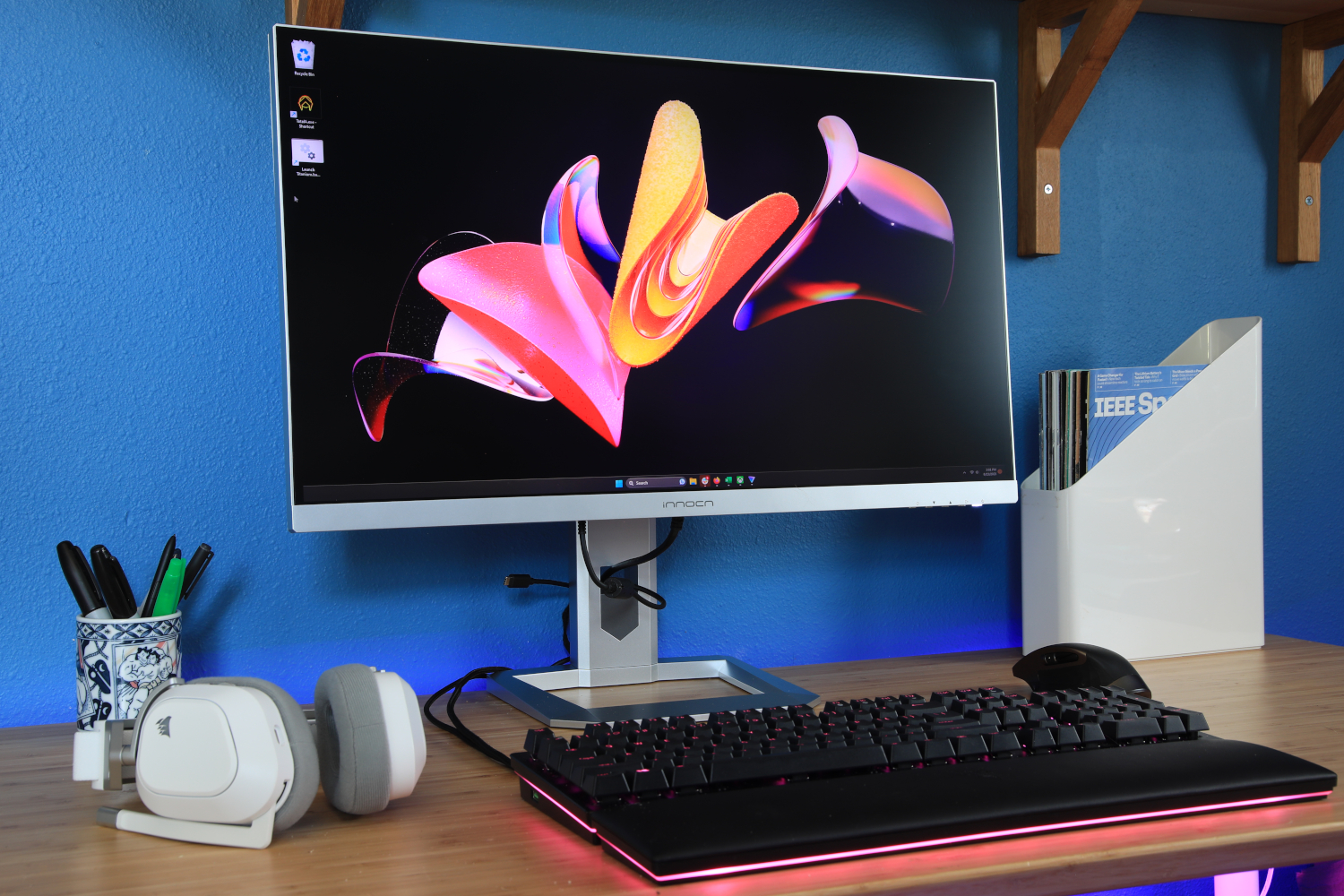
 Read our reviewPrice When Reviewed:$679.99Best Prices Today:$599.99 at Amazon | $749.99 at Innocn
Read our reviewPrice When Reviewed:$679.99Best Prices Today:$599.99 at Amazon | $749.99 at Innocn
The Dell Ultrasharp U2724D doesn’t offer HDR but, given the monitor’s price range, it’s not a surprise. Monitors under $500 typically struggle to handle HDR, as they lack the brightness and contrast necessary to deliver good detail in extremely bright, or dark, scenes. Those seeking strong HDR performance must invest in more expensive monitors like the Innocn 27M2V or Alienware AW3423DWF.
How is the Dell Ultrasharp U2724D’s motion performance?
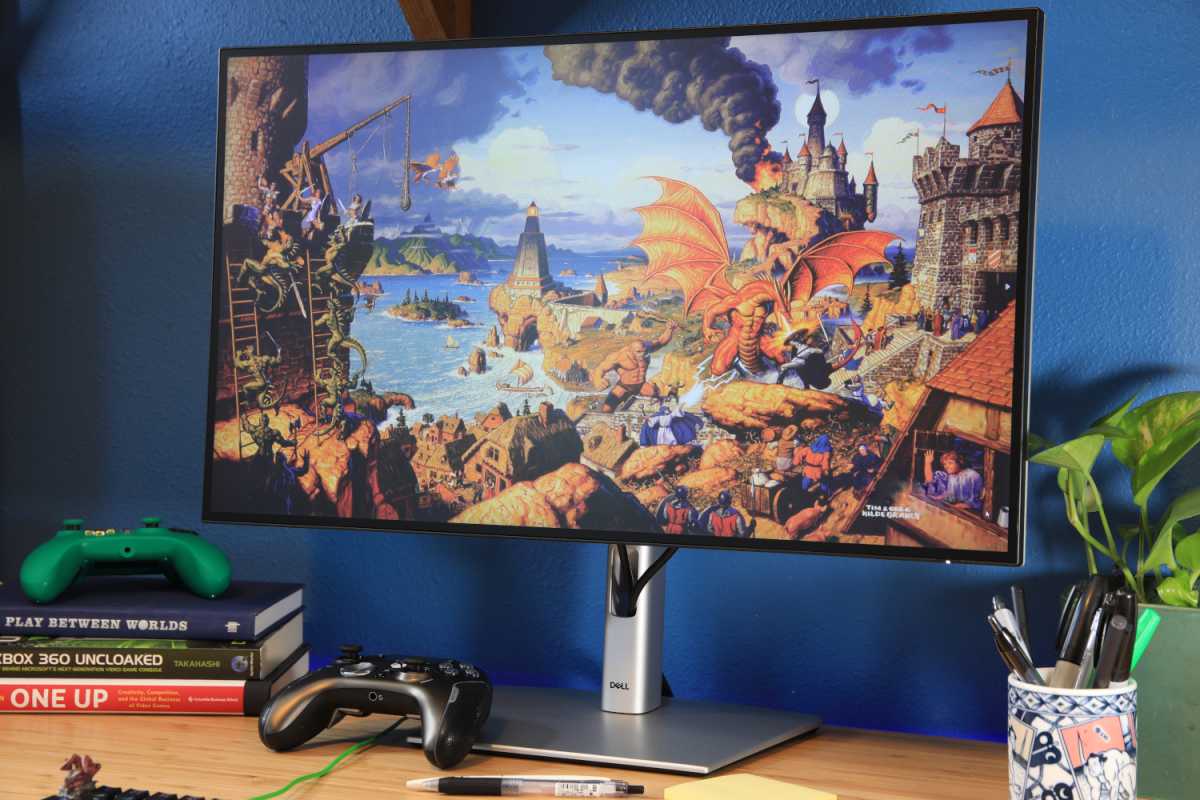
The Dell Ultrasharp U2724D comes with a 120Hz refresh rate.
The Dell Ultrasharp U2724D comes with a 120Hz refresh rate.
Matt Smith
The Dell Ultrasharp U2724D comes with a 120Hz refresh rate.
Matt Smith
Matt Smith
I’ve frequently complained about the Dell Ultrasharp line-up’s restrained approach to refresh rate. Most monitors lack a refresh rate meaningfully enhanced over 60Hz (sorry, Dell, but 75Hz doesn’t count). Fortunately, Dell has made the leap to 120Hz with several monitors including the U2724D (the U2724DE, U2424H, and U2424HE also hit 120Hz). It’s a key improvement. Doubling the refresh rate from 60Hz to 120Hz improves motion smoothness and clarity not only in games, but also on the Windows desktop.
Gamers should keep expectations in check. The monitor quotes pixel response times of 5 to 8 milliseconds, which is slower than a typical gaming monitor (most quote a response time of 1 to 3 milliseconds). Because of this, the U2724D’s motion is not as crisp as some price-competitive monitors with a similar refresh rate. Even the KTC H24T09P, a $150 gaming monitor I recently reviewed, was a tad more crisp in motion.
But it’s important not to miss the forest for the trees. The U2724D can’t stand up to the motion clarity of a gaming monitor, but it’s not too far behind, and it easily defeats a monitor stuck at 60Hz. Remember, also, that a game must render at a frame rate equivalent to a monitor’s maximum refresh rate to really see the full benefit of that enhanced refresh rate. That’s worth thought when buying a mid-range monitor, as I’d guess most shoppers looking at the U2724D don’t plan to pair it with an expensive high-performance GPU.
The Dell U2724D supports adaptive sync for smooth, tear-free gameplay, but the details are confusing. The monitor doesn’t have official AMD FreeSync or Nvidia G-Sync support but does support “VRR as per specified in HDMI 2.1.” Despite that, my AMD Radeon 7800 XT video card recognized the Dell U2724D as an Adaptive Sync Compatible display over both HDMI and DisplayPort, and adaptive sync was functional in my testing. I expect adaptive sync will work with most AMD and Nvidia graphics solutions—but, given the lack of official support, it’s not guaranteed.
Is the Dell Ultrasharp U2724D worth it?
The Dell Ultrasharp U2724D is an excellent monitor that strikes the right balance of features, image quality, and ergonomics. This makes the monitor a good choice for nearly any shopper. It’s especially excellent for people who need a display that’s equally strong in office productivity, content creation, and gaming. The monitor’s only weakness is its connectivity, which forces shoppers looking for Thunderbolt 4/USB-C with DisplayPort to upgrade to the more expensive U2724DE. Not everyone needs that feature, however, and the monitor has acceptable downstream USB connectivity. It’s a versatile, attractive display that delivers good value for money.
Author: Matthew S. Smith
Matthew S. Smith is a freelance technology journalist with 15 years of experience reviewing consumer electronics. In addition to PCWorld, his work can be found on Wired, Ars Technica, Digital Trends, Reviewed, IGN, and Lifewire. Matthew also covers AI and the metaverse for IEEE Spectrum and runs Computer Gaming Yesterday, a YouTube channel devoted to PC gaming history.
Recent stories by Matthew S. Smith:
Pixio PX248 Wave review: A monitor for fashion, flair, and clarity on a budgetBest portable monitors 2024: Displays that go with youBest ultrawide monitors 2024: Let’s get large


